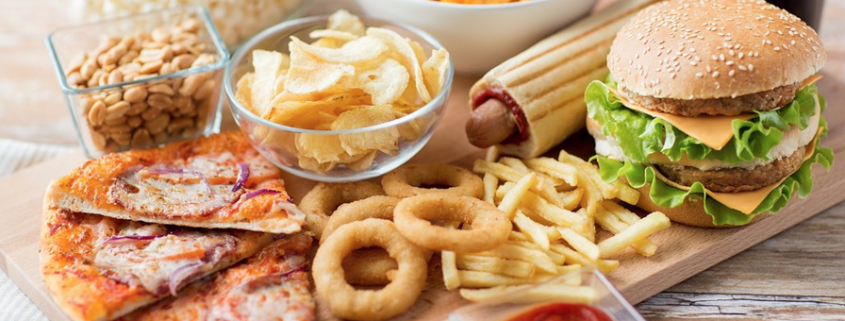There’s a very fine line between maintaining a healthy body weight and being malnourished. Truth is, in this day in age when thin is in, a lot of people are simply starving themselves. They are cutting calories too much, eating too little, and, ultimately, depriving their bodies of health-promoting nutrients—All in an effort to maintain a certain level of thinness.
Related Article: Appearances Can Be Deceiving: Why Being Thin Doesn’t Equate to Being Healthy
But, emaciation isn’t the only manifestation of malnutrition. There’s actually another side of the equation that’s all too often overlooked.
That is, the role of malnutrition in weight gain.
Right now, you’re probably thinking, “How is that even possible?”
Well, I’m here to tell you that it’s actually quite common for obese people to be malnourished.
In fact, the process of weight gain itself is largely driven by malnutrition. It’s a combined result of consuming too many calories and taking in too little nutrients. The body craves nutrients, not calories. To understand how, you must first understand the difference between the two, specifically the terms “nutrient-dense” versus “calorie-dense” in relation to food composition.
Foods that are nutrient-dense generally supply an abundance of high-quality nutrients relative to the number of calories they provide.
Related Article: Macronutrients: Three Key Essentials of Healthy Eating
These are the foods the body inherently craves!
Nutrients of high-quality include good carbohydrates, healthy fats and lean protein along with essential vitamins and minerals, many of which have potent antioxidant effects. High-quality nutrients are widely present in fruits and vegetables, nuts and seeds, legumes (beans and peas), high-fiber whole grains, and certain animal-based foods including seafood and fish, lean meats, and poultry.
On the flip side, calorie-dense foods essentially refer to any and all calorie-containing foods (and beverages) that are low in or completely devoid of nutrients. These “empty-calorie” foods tend to be highly processed, rich in unhealthy fats, and loaded with added sugars, salt, and other preservatives.
Related Article: Tip to Dieters: Beware of Empty Calorie Foods
Among the laundry list of common empty-calorie foods are candies, pastries, desserts, sugary cereals, processed meats, junk foods, soft drinks, and alcohol. But, many “low-fat” and “low-calorie” foods masked as “healthy” can also be classified as calorie-dense or ’empty’ including pretzels, baked chips, fruit juice and flavored waters, low-fat ice cream, fat-free salad dressings, and of course those ole “100-calorie” snack packs.
Related Article: Are Processed Meats Really Bad for Your Health?
Consider pretzels, for example, which are often classified as ‘healthy’ due to their 100-calorie status and low content of added sugars.
Aside from the 20-25 grams of fiber-less carbohydrates they contain, pretzels are completely devoid of nutrients rendering most, if not all, 100 calories as ’empty’ carbs. Due to this utter lack of nutrients, pretzels are digested and absorbed by the body just as quickly as pure sugar so eating them will leave you starving for more.
The same holds true with just about every high-carb snack that’s processed, pre-packaged, and ready-to-eat.
Now, consider nuts and seeds, which supply a whopping 200 calories per 1/4-cup serving. In spite of their relatively high calorie counts, nuts and seeds are packed full of good carbs and fiber, healthy fats, and minerals and are, therefore, nutrient-dense.
So, needless to say, a calorie isn’t always a calorie!
A 200-calorie portion of nuts will always be more nutritious than a 100-calorie snack. Due to their rich content of fiber and fat, nuts are also a heck of a lot more satiating to the body. Yet, I can’t tell you how often dieters shun walnuts over pretzels due to their relatively higher calorie count.
Related Article: 3 Highly Effective Ways to Lose Weight Without Counting Calories
Interestingly enough, stereotypical ‘healthy eating’ practices are often an underlying culprit behind failed diets. These include day-to-day consumption of “zero-calorie” and “low-calorie” foods artificially enriched with fiber and other nutrients. In truth, ‘nutrient-enhanced’ foods are no substitute for whole foods.
And, in spite of people’s efforts to eat well, regularly feasting on these foods is what actually drives malnutrition.
This is just one of the many sad consequences of the standard Western diet.
Among all nutrients, vitamins and minerals are the most lacking. In and of themselves, these nutrients (collectively known as “micronutrients”) enable the breaking down and processing of carbohydrates, fats, and protein obtained from the diet so they can be used to carry out vital bodily functions.
Foremost among these functions are blood sugar (glucose) regulation and fat metabolism (burning), which are the cornerstones of weight management and overall good health.
For instance, the vitamin D housed in oily fish varieties (salmon, tuna, and sardines) supports the regulation of blood sugar by improving the body’s response to insulin (the hormone responsible for lowering blood glucose). Similarly, B-vitamins housed in vegetables, helps the body unleash the protein and omega-3 fatty acids contained in fish.
Related Article: How Insulin Impacts Fat Burning and Weight Loss
Collectively, these effects support fat burning while blocking fat storage, thereby supporting weight loss and healthy weight management.
So, obviously eating a meal comprised of salmon and spinach is a winning combination as opposed to simply downing a nutrient-enhanced weight loss shake.
Just think about why for a second.
Now, I want you to think about your personal dietary patterns and all the foods you consume on a daily basis.
Are you filling your body up with empty-calories at the expense of good nutrition?
If so, this is definitely a problem!
Not only are empty-calorie foods inherently calorie-dense, but they can quickly fill up your stomach to its capacity, leaving little room for nutrient-dense foods. This causes your metabolism to spiral out of control, as the body is filled with unusable foods and devoid of the vitamins, minerals and other nutrients needed to properly break them down.
Related Article: The Important Role of Metabolism in Weight Loss
As a result, any and all excess calories unused by your body are more likely to be stored as fat.
Adding insult to injury, since your body is basically ‘starving’ for nutrients, it’ll constantly ask for more food until those nutrients are readily available.
This vicious cycle of malnutrition is generally manifested in persistent hunger and food cravings, which are essentially ‘nutrient’ cravings. Eat more empty-calorie foods to satisfy hunger and cravings and you’re simply promoting further nutrient cravings. This’ll trigger overeating, encourage fat storage, and, ultimately, result in weight gain.
Remember, the body craves nutrients, not calories!
So, before you eat something, ask yourself one simple question: “How is this food nourishing my body?”
If you don’t have an answer, you probably don’t need to eat it.
At the end of the day, whether you’re underweight or overweight, eating a sensible diet that’s well-balanced in nutrients is the absolute best way to keep your body in a completely nourished state. Find out how it’s done!







